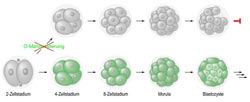How Sugar Molecules Influence Embryonic Development

Early phase of embryonic development<br>Image source: M. Loibl and S. Strahl <br>
Sugar molecules are crucial to cell adhesion, the specific interaction between cells, and hence to the development of the embryo. This is the conclusion reached by Prof. Dr. Sabine Strahl and her team at the Centre for Organismal Studies at Heidelberg University.
Their research shows that a special form of glycosylation, in which sugar molecules bind to proteins, is essential to the function of E-cadherin-mediated cell adhesion. According to Prof. Strahl, differentiation of the embryo is impossible if this protein modification is lacking. The results of the research were published in the journal “PNAS”.
In the early phase of embryonic development, the fertilised egg divides, forming a ball of loosely bound cells called the morula. For a compact cell packet and finally a complex organism to develop, the cells first need to bind tightly together.
Cell adhesion molecules like E-cadherin are essential in this process. Cadherins are proteins that enable tissues to bind together and cells to communicate with one another. In all living organisms, numerous sugar molecules are bound to proteins after biosynthesis. This process, called glycosylation, is critical for growth and development. “The lack of certain sugar residues can lead to serious congenital development disorders in humans,” explains Prof. Strahl.
The research team was now able to demonstrate in the mouse model why a certain type of glycosylation, called protein O-mannosylation, is critical to early embryonic development. The researchers proved that the E-cadherin protein carries mannose, sugar molecules present on the surface of the embryonic cells as of the four-cell stage of development. If biosynthesis of these E-cadherin-bound sugar residues is inhibited, functional cell connections cannot form and the cells cannot bind together with any stability. This leads to death of the embryo even before it can embed itself in the womb.
“The causal relationship we demonstrated between the sugar residues and cadherin-mediated cell adhesion shows that this protein modification is much more important than originally believed,” says Sabine Strahl. “In view of the important functions of cadherins in development processes in vertebrates as well as in tumour metastasis, our work is extremely relevant in many areas of the life sciences and medical research.” Based on the results of their research, the Heidelberg scientists now plan to investigate the significance of this protein modification in the genesis of cancer.
Their research was funded by the “Glycobiology/Glycomics” programme of the Baden-Württemberg Foundation. Scientists from the Gene Center of the University of Munich (LMU) also contributed to the research work.
Internet information:
http://www.cos.uni-heidelberg.de/index.php/s.strahl?l=_e
Original publication:
M. Lommel, P.R. Winterhalter, T. Willer, M. Dahlhoff, M.R. Schneider, M.F. Bartels, I. Renner-Müller, T. Ruppert, E. Wolf, and S. Strahl: Protein O-mannosylation is crucial for E-cadherin-mediated cell adhesion, PNAS (2 December 2013), doi: 10.1073/pnas.1316753110
Caption:
In the early phase of embryonic development, the fertilised egg divides and within two days forms a ball of loosely bound cells called the morula. The bonds between these cells are fortified, resulting in a compact cell packet, the blastocyst. In the mouse, sugar residues bound to E-cadherin (mannose; green) can be detected on the surface of the embryonic cells starting at the four-cell stage. If their biosynthesis is inhibited, the cells cannot form stable bonds during the transition from the morula to the blastula stage. A blastocyst cannot be formed and the faulty embryos are resorbed.
Image source: M. Loibl and S. Strahl
Contact:
Prof. Dr. Sabine Strahl
Centre for Organismal Studies (COS)
Phone +49 6221 54-6286
sabine.strahl@cos.uni-heidelberg.de
Communications and Marketing
Press Office, phone: 49 6221 54-2311
presse@rektorat.uni-heidelberg.de
Media Contact
More Information:
http://www.cos.uni-heidelberg.de/index.php/s.strahl?l=_eAll latest news from the category: Life Sciences and Chemistry
Articles and reports from the Life Sciences and chemistry area deal with applied and basic research into modern biology, chemistry and human medicine.
Valuable information can be found on a range of life sciences fields including bacteriology, biochemistry, bionics, bioinformatics, biophysics, biotechnology, genetics, geobotany, human biology, marine biology, microbiology, molecular biology, cellular biology, zoology, bioinorganic chemistry, microchemistry and environmental chemistry.
Newest articles

Properties of new materials for microchips
… can now be measured well. Reseachers of Delft University of Technology demonstrated measuring performance properties of ultrathin silicon membranes. Making ever smaller and more powerful chips requires new ultrathin…

Floating solar’s potential
… to support sustainable development by addressing climate, water, and energy goals holistically. A new study published this week in Nature Energy raises the potential for floating solar photovoltaics (FPV)…

Skyrmions move at record speeds
… a step towards the computing of the future. An international research team led by scientists from the CNRS1 has discovered that the magnetic nanobubbles2 known as skyrmions can be…





















